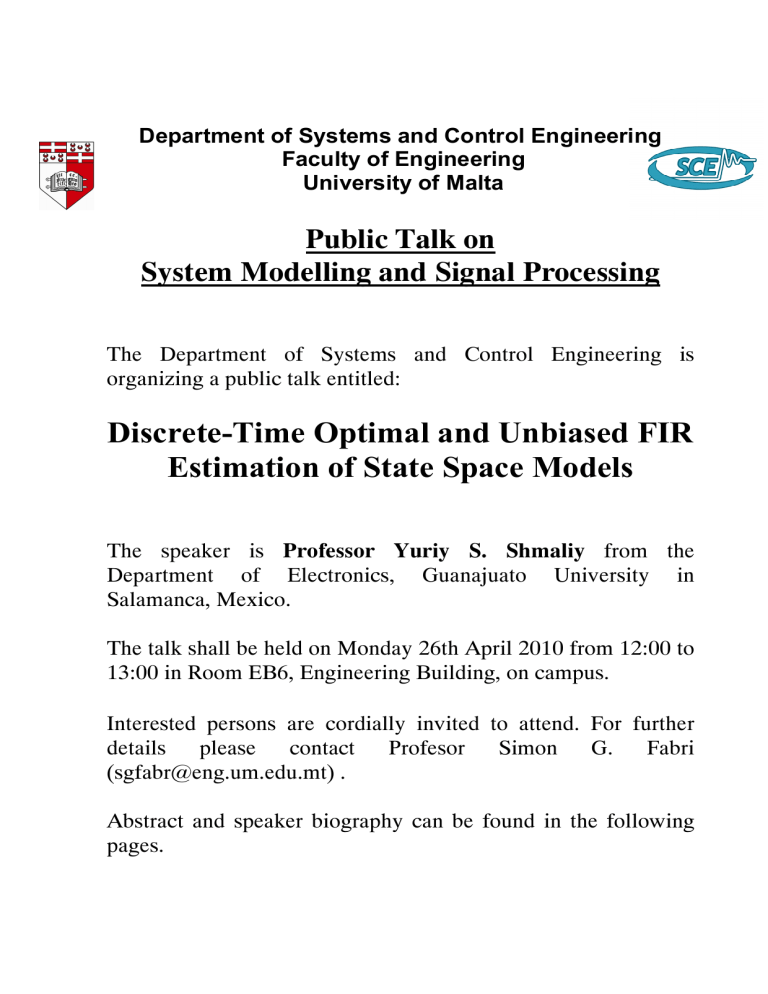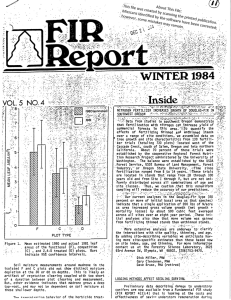Discrete-Time Optimal and Unbiased FIR Estimation of State Space Models

Department of Systems and Control Engineering
Faculty of Engineering
University of Malta
Public Talk on
System Modelling and Signal Processing
The Department of Systems and Control Engineering is organizing a public talk entitled:
Discrete-Time Optimal and Unbiased FIR
Estimation of State Space Models
The speaker is Professor Yuriy S. Shmaliy from the
Department of Electronics, Guanajuato University in
Salamanca, Mexico.
The talk shall be held on Monday 26th April 2010 from 12:00 to
13:00 in Room EB6, Engineering Building, on campus.
Interested persons are cordially invited to attend. For further details please contact Profesor Simon G. Fabri
(sgfabr@eng.um.edu.mt) .
Abstract and speaker biography can be found in the following pages.
Presentation
Discrete-Time Optimal and Unbiased FIR Estimation of State Space Models
Professor Yuriy S. Shmaliy
Department of Electronics,
FIMEE, Guanajuato University,
Salamanca, 36885, Mexico
E-mail: shmaliy@salamanca.ugto.mx
Abstract: Optimal estimation of signal parameters and system models is often required to formalize a posteriori knowledge about undergoing processes in the presence of noise.
Therefore, filtering, smoothing, and prediction have become key tools of statistical signal, image, and speech processing and found applications in algorithms of various electronic systems. Very often, estimation is provided using methods of linear optimal filtering employing either finite impulse response (FIR) or infinite impulse response (IIR) structures. First fundamental works on discrete-time optimal linear filtering of stationary random processes were published in 1939-
1941 by Kolmogorov as mathematically-oriented. Soon after, Wiener solved the problem for engineering applications in continuous-time and Levinson used the Wiener error criterion in filter design and prediction. The solutions by Wiener were all in the frequency domain, presuming IIR solutions. A FIR modification to the Wiener filter was made by Zadeh and
Ragazzini. Thereafter, Johnson extended Zadeh-Ragazzini's results to discrete time. The roots of optimal FIR filtering can be found namely in these basic works. Despite the inherent bounded input/bounded output stability and robustness against temporary model uncertainties and round-
off errors, practical interest to FIR filtering weakened after Kalman and Bucy presented in 1960-
1961 complete results on the theory of linear filtering of nonstationary Gaussian processes. In contrast to the FIR solutions implying large computational burden and memory, the recursive IIR
Kalman-Bucy algorithm has appeared to be simple, accurate, and fast. That has generated an enormous number of papers devoted to the investigation and application of this filter. It then has been shown that the Kalman filter is a nice solution if the model is distinct, there are no uncertainties, and noise sources are all white sequences. Otherwise, the algorithm may become unstable and its estimate may diverge. An interest to FIR structures has grown in recent decades owing to a dramatic development in computational resources. In receding horizon predictive control, significant results on optimal linear FIR filtering of Gaussian processes have been achieved by Jazwinski, Liu and Liu, Ling and Lim, and Kwon et al. For image processing, predictive FIR filtering has been proposed by Heinonen and Neuvo and thereafter developed by many authors. For polynomial models, FIR structures were used by Wang to design a nonlinear filter, by Zhou and Wang in the FIR-median hybrid filters, and a number of publications keep growing.
In this presentation, we show that the general theory of the p-shift optimal linear FIR estimator follows straightforwardly from the real-time state space model (from n and n-1 to n) used in signal processing, rather than from the prediction model (from n to n+1) used in control. This model allows for a universal estimator intended for solving the problems of filtering (p = 0), prediction (p > 0), and smoothing (p < 0) in discrete-time and state space on a horizon of N points. In such an estimator, the initial state is self-determined by solving the discrete algebraic
Riccati equation (DARE). The noise components are allowed to have arbitrary distribution and covariance functions with a particular case of white Gaussian approximation. Depending on p, the estimator is readily modified to solve several specific problems, such as the receding horizon control one (p = 1), smoothing the initial state (p =
−
N+1), holdover in digital communication networks (p > 0), etc. We show that the optimal FIR estimator gain is a product of the unbiased gain and the noise-dependent function composed with the covariance functions and the initial state function. An important point is that the optimal and unbiased estimates converge either when the convolution length is large, N >> 1, or if the initial state error dominates the noise components. The unbiased (near optimal) FIR estimate associated with the best linear unbiased estimator (BLUE) is considered in detail as having strong engineering features. Along with the noise power gain (NPG), this estimate can be represented in batch and recursive Kalman-like forms. A special attention is paid to the polynomial state space models as being basic for many applications. For this model, the unique low-degree polynomial gains are derived and investigated in detail. Applications are given for polynomial state space modeling, clock state estimation and synchronization, and image processing. The trade-off with the Kalman algorithm is also discussed and supported with experimental results.
Brief Biography of the Speaker:
Professor Yuriy S. Shmaliy is a Full Professor of Electronics of the School of Mechanical,
Electrical, and Electronic Engineering (FIMEE) of the University of Guanajuato, Mexico. He received the B.S., M.S., and Ph.D. degrees in 1974, 1976 and 1982, respectively, from the
Kharkiv Aviation Institute, Ukraine, all in Electrical Engineering. In 1992 he received the Doctor of Technical Sc. degree from the Kharkiv Railroad Institute. In March 1985, he joined the
Kharkiv Military University. He serves as Full Professor beginning in 1986. Since 1999 to 2009, he has been with the Kharkiv National University of Radio Electronics.
Prof. Shmaliy has 250 Journal and Conference papers and 80 patents. His books Continuous-
Time Signals (2006) and Continuous-Time Systems (2007) were published by Springer. His book
GPS-Based Optimal FIR Filtering of Clock Models (2009) was published by Nova Science
Publ., New York. He also contributed with several invited Chapters to books. He was rewarded a title, Honorary Radio Engineer of the USSR, in 1991. He was listed in Marquis Who's Who in the World in 1998; Outstanding People of the 20th Century, Cambridge, England in 1999; and
Contemporary Who's Who, American Bibliographical Institute, in 2002. He is a Senior Member of IEEE. He has Certificates of Recognition and Appreciation from the IEEE, WSEAS, and
IASTED. He serves as an Associate Editor in Recent Patents on Space Technology. He is a member of several Organizing and Program Committees of Int. Symposia. He organized and chaired several International Conferences on Precision Oscillations in Electronics and Optics. He was multiply invited to give tutorial, seminar, and plenary lectures. His current interests include optimal estimation, statistical signal processing, and stochastic system theory.





